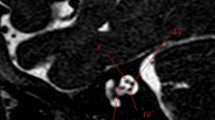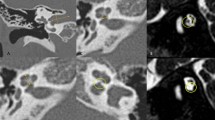Abstract
Background
Cochlear implantation has become an accepted treatment for deafness. As the frequency of cochlear implantation has increased, requests for images have also increased in the work-up for candidates. An absent cochlear nerve (CN) is a contraindication to cochlear implantation. Therefore, MRI is performed to evaluate the CN in patients with sensorineural hearing loss. Recently, some authors have reported the relationship between cochlear nerve canal (CNC) stenosis and CN hypoplasia.
Objective
To review the relationship between CNC and CN.
Materials and methods
During a period of 78 months, 21 children (42 ears) with unilateral or bilateral sensorineural hearing loss underwent both HRCT and MRI of the cochlear nerve. We retrospectively reviewed two factors: the evaluation of inner ear malformations and the relationship between CNC stenosis and CN hypoplasia.
Results
Inner ear malformations were recognized in ten ears. The mean CNC diameter was approximately 2 mm (ranging from 0.6 to 2.7 mm). CN hypoplasia was seen in eight of the 42 ears; all eight were associated with CNC stenosis (≤1.5 mm). Of the 34 ears with normal CN, 32 had CNC >1.5 mm in diameter and the remaining two ears, with incomplete partition type I, had CNC stenosis.
Conclusion
Children with CNC stenosis had a high incidence of CN hypoplasia. CNC stenosis (≤1.5 mm) suggests CN hypoplasia. On the other hand, CN hypoplasia was not seen in children with CNC diameter >1.5 mm. Therefore, we conclude that children with CNC stenosis or malformations on HRCT should receive MR imaging of the CN.





Similar content being viewed by others
References
Adunka OF, Roush PA, Teagle HF et al (2006) Internal auditory canal morphology in children with cochlear nerve deficiency. Otol Neurotol 27:793–801
Lowe LH, Vezina LG (1997) Sensorineural hearing loss in children. Radiographics 17:1079–1093
Russo EE, Manolidis S, Morriss MC (2006) Cochlear nerve size evaluation in children with sensorineural hearing loss by high-resolution magnetic resonance imaging. Am J Otolaryngol 27:166–172
Witte RJ, Lane JI, Driscoll CL et al (2003) Pediatric and adult cochlear implantation. Radiographics 23:1185–1200
Casselman JW, Offeciers FE, Govaerts PJ et al (1997) Aplasia and hypoplasia of the vestibulocochlear nerve: diagnosis with MR imaging. Radiology 202:773–781
Glastonbury CM, Davidson HC, Harnsverger HR et al (2002) Imaging findings cochlear nerve deficiency. AJNR 23:635–643
Kono T (2008) Computed tomographic features of the bony canal of the cochlear nerve in pediatric patients with unilateral sensorineural hearing loss. Radiat Med 26:115–119
Fatterpekar GM, Mukherji SK, Alley J et al (2000) Hypoplasia of the bony canal for the cochlear nerve in patients with congenital sensorineural hearing loss: initial observations. Radiology 215:243–246
Komatsubara S, Haruta A, Nagano Y et al (2007) Evaluation of cochlear nerve imaging in severe congenital sensorineural hearing loss. ORL J Otorhinolaryngol Relat Spec 69:198–202
Sennaroglu L, Saatci I (2002) A new classification for cochleovestibular malformations. Laryngoscope 112:2230–2241
Kim HS, Kim DI, Chung IH et al (1998) Topographical relationship of the facial and vestibulocochlear nerves in the subarachnoid space and internal auditory canal. AJNR 19:1155–1161
Ferreira T, Shayestehfar B, Lufkin R (2003) Narrow, duplicated internal auditory canal. Neuroradiology 45:308–310
Demir OI, Cakmakck H, Erdag TK et al (2005) Narrow duplicated internal auditory canal: radiological findings and review of the literature. Pediatr Radiol 35:1220–1223
Weon YC, Kim JH, Choi SK et al (2007) Bilateral duplication of the internal auditory canal. Pediatr Radiol 37:1047–1049
Bail HW, Yu H, Kim KS et al (2008) A narrow internal auditory canal with duplication in a patient with congenital sensorineural hearing loss. Korean J Radiol 9:S22–S25
McClay JE, Booth TN, Parry DA et al (2008) Evaluation of pediatric sensorineural hearing loss with magnetic resonance imaging. Arch Otolaryngol Head Neck Surg 134:945–952
Trimble K, Blaser S, James AL et al (2007) Computed tomography and/or magnetic resonance imaging before pediatric cochlear implantation? Developing an investigative strategy. Otol Neurotol 28:317–324
Shim HJ, Shin JR, Chung JW et al (2006) Inner ear anomalies in cochlear implants: importance of radiologic measurements in the classification. Otol Neurotol 27:831–837
Jackler RK, Luxford WM, House WF (1987) Congenital malformations of the inner ear: a classification based on embryogenesis. Laryngoscope 97:2–14
Shelton C, Luxford WM, Tonokawa LL et al (1989) The narrow internal auditory canal in children: a contraindication to cochlear implants. Otolaryngol Head Neck Surg 100:227–231
Adunka OF, Jewells V, Buchman CA et al (2007) Value of computed tomography in the evaluation of children with cochlear nerve deficiency. Otol Neurotol 28:597–604
Sennaroglu L, Saatci I, Aralasmak A et al (2002) Magnetic resonance imaging versus computed tomography in pre-operative evaluation of cochlear implant candidates with congenital hearing loss. J Laryngol Otol 116:804–810
Stjernholm C, Muren C (2002) Dimension of the cochlear nerve: a radioanatomic investigation. Acta Otolaryngol 122:43–48
Maxwell AP, Mason SM, O’Donoghue GM (1999) Cochlear nerve aplasia: its importance in cochlear implantation. Am J Otol 20:335–337
Author information
Authors and Affiliations
Corresponding author
Rights and permissions
About this article
Cite this article
Miyasaka, M., Nosaka, S., Morimoto, N. et al. CT and MR imaging for pediatric cochlear implantation: emphasis on the relationship between the cochlear nerve canal and the cochlear nerve. Pediatr Radiol 40, 1509–1516 (2010). https://doi.org/10.1007/s00247-010-1609-7
Received:
Revised:
Accepted:
Published:
Issue Date:
DOI: https://doi.org/10.1007/s00247-010-1609-7




